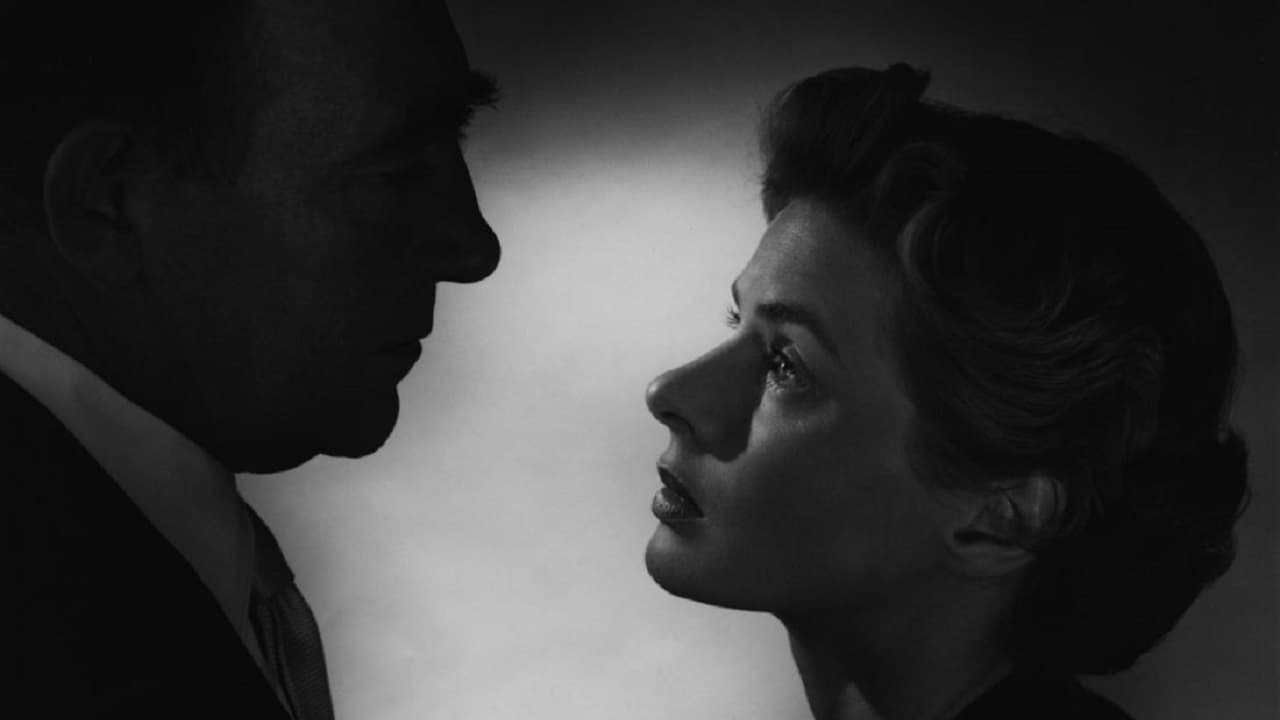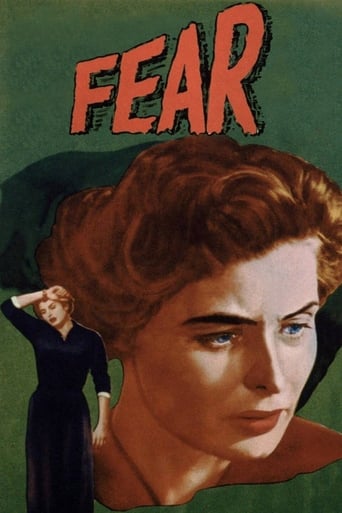



ridiculous rating
Don't listen to the Hype. It's awful
The movie's neither hopeful in contrived ways, nor hopeless in different contrived ways. Somehow it manages to be wonderful
View MoreGreat story, amazing characters, superb action, enthralling cinematography. Yes, this is something I am glad I spent money on.
View More"Non credo più all'amore (La paura)" or simply "Fear" is a co-production between West Germany and Italy that resulted in a black-and-white movie from 1954, so this one is already way over 60 years old. It was co-written and directed by Roberto Rossellini and the main character is once again played by his (then still) wife Ingrid Bergman. According to IMDb, this one is slightly longer than 80 minutes, but the version I saw was even 10 minutes shorter, so it is not a long movie at all and there exist several versions. The original work this is based on is by Stefan Zweig and I suggest the recent Maria Schrader video to everybody who is curious about the author. Zweig's involvement may also have to do with the film having the main language German, but I am not too sure if this is accurate looking at the film's title and also the cast. At least the version i watched was exclusively Italian with English subtitles.This is a story about fear as the title already states and relationship struggles play a major role as well as in many other Bergman films. Moonlighting and blackmailing are crucial components in the story here, but lets be honest, all in all it is really a major Bergman showcase as well and honestly beyond her acting I think the story is not as good as it could have been. If you are a Bergman fan, you will probably enjoy this one as she has several scenes in which she can shine, but I myself have seen not too much from her yet and what I saw here does not really get me curious about her other works or Rossellini's. I myself was glad that the film was over relatively quickly as I cared little for the story or character(s) eventually. I give it a thumbs-down and like I said I only recommend it to the very biggest Bergman fans.
View MoreThis appears to have been mysteriously lost when the history of cinema was being written. It is a hard film to place anyway. Rossellini had hit his stride and was on his way out of the public mind, it's far from the neorealism he became famous for, it's not lurid enough to pass as noir. Antonioni had not yet arrived at Cannes to reinvent the vision present here inside a modernist framework. All this is made worse by the meddling of Italian distributors, anxious for ticket sales. Subsequent generation of film-watchers would have stumbled (if at all) upon something too small, an unfulfilling, incomplete affair.But like so many of these flawed pieces, it is endlessly fascinating. Rossellini was blessed with a gift; his work is not the result of a fiery intuition bursting forth, but of a studied, assured awareness. Grasping and what is grasped become one in his films. It's hard to conceive the great Antonioni, who was so inspired by him and who really opened up what Rossellini contained within a religious language, without a film like this or Stromboli. From a distance, it's simple enough: a story of marital infidelity (which, like Stromboli, inadvertently resonates out of the film and into the illicit love Bergman and Rossellini shared), about a woman's descend into paranoid fear and delusion. An image of the fractured self, painfully learning the lesson that makes whole. Between grief and nothing, as Faulkner would have it.But such richness of appearances. How inner disturbance seeps outside; in the piano concert scene, notice how the music swells from placid to nerve-wracking crescendo. Notice the downpour that accompanies the razorblade-edge crisis of conscience. When the noose begins to be pulled tight around her neck as the husband inquires about a missing ring, faces are drowned in a sludge of shadow like out of Weimar noir.Further inside; the threatening image of the ogre-father to be appeased, with the daughter and wife one before his gaze. He holds the keys to both punishment and forgiveness. The suffering and humiliation born from delusion and desire, and how they trap the soul in chimeras.The other thing I want to stand on is what was originally intended of the compromised vision we have available. Rossellini's daughter is reportedly working to restore the original, a time-consuming affair in most cases, but until then this is all we have.A fishing scene is missing and tiresomely expositional monologue is added in two scenes; from what I could gleam, the opening and finale. Both marvelous renditions of wanderings through night streets, itself an aesthetic ahead of the times. And then the most important thing of all, that pushes the film into cinematic apotheosis. The finale, which the distributors meddled to turn into a cloying sentimentality that ensures closure and balance.Rossellini intended the film to end with a suicide attempt (we see the prelude, with Irene writing her suicide note), but then she thinks of her children and returns home. Rossellini shot footage of this. The footage comprises two shots; one is the shot filmed from inside a car crossing idyllic countryside to reach the remote cottage house, the other is Irene in her favorite armchair as her childhood nanny soothes her.Both these shots were repeated earlier in the film, when Irene and her husband first get to the cottage. To the place where Irene grew up, where her children are now. Childhood comfort is possible there, as refuge from the punishing dead-ends of adult life. We see her, as again in the finale, reclining on her armchair with her nanny by her side.So we have in th end Irene anguishing over her suicide note on her desk; then her regressive trip back into the place of comfort. Whatever end we get in the coming restoration, this is one of the most potent finales in pre-60's cinema, the suicide all there disguised as the journey back.
View MoreThe Italian director Roberto Rossellini is mostly known, and has gained his reputation as a great director mainly for his neorealistic films from the 1940's. However, by the 1950's he had moved on and concentrated on depicting human relations, mostly couples who are going some sort of a marital crisis."La paura" (fear in English; actually its original title is "Die Angst", because the film is in German not like in Germania anno cero, which did take place in Germany, but whose characters spoke Italian) can be seen in continuance with these works, for example with "Viaggio in Italia" (1954), where Ingrid Bergman also plays the female protagonist. "La Paura" focuses on showing the emotional distress and literally the fear of a woman who has had an extra-marital relationship and who is, besides tormented by her infidelity, now being blackmailed by her lover's ex-girlfriend.In no way could this film be characterized as neorealistic, so obvious is the use of melodramatic music to underline the suspense, and furthermore the film doesn't really criticize the society as it does its individuals in their private affairs (or does it?). Genrewise, it is located somewhere between a melodrama and a psychological thriller. It owes a lot to the German expressionism of the 1920's in its use of shadows and camera angles, and might be defined as somewhat film noirish (which isn't actually a genre, but a style) both in its gloomy imagery and in its ambiguous moral universe. In film noir the world is always a twisted place, where traditional values have been lost and individuals feel alienated, all of which is connected to the threatening urban atmosphere. Normally women are corrupt and not to be trusted, but in this European version the most cruel role plays the husband, who is mercilessly putting his wife on a test, as he himself has hired the girl to blackmail his wife.One of the most memorable scenes shows Irene Wagner (Bergman) following her husband's crew performing a laboratory test on a guinea pig, where first poison and then antidote are injected in the object-victim. The monotonous and anguish-producing sound from the measurement device makes the scene a small masterpiece, corresponding with and further emphasizing Irene's agony.The etymology of the original title 'Angst' (anguish) carries within the meaning 'godless', which is not too far-fetched as the film's persons are concerned. Without God there is no homogeneous moral construction, and so no universal ethics or values exist. This can be extended to the end of Great Narratives, which might have existed still in the 1950's, but in general there was no universal guideline to follow. People, individuals, are thrown into a world full of insecurity, and there lives appear to be meaningless. Their actions seem often sporadic and they can't really empathize with other people's feelings. In the end the husband saves her wife from suicide and they embrace each other in fervor, repeating "I love you" an ending very similar to that of Viaggio in Italia. The film ends very abruptly after having reached its climax, which left me doubtful on the credibility of the outcome and made the solution seem merely a pseudo closure (as David Bordwell calls a closure which seems forced and thus false).All in all, I recommend this film as another case study on human psyche.
View MoreI viewed a copy of a copy on video of this film and so the video quality was not that great. First, what did I like and not like? I didn't like the beginning or ending, but the rest of the movie was very good. Ingrid Bergman does a very fine job as the wife who has a secret to hide and will go to great lengths out of fear, hence the title of the movie, to prevent her husband from finding out. As the husband, Mathias Wieman does an excellent job playing the part of the kind, understanding Professor Wagner who is not as he seems. Overall, the film is a fine psychological thriller in the manner of Hitchcock and I won't give away the film noirish plot twist or the problematic, to me, ending. This movie is little known but well worth a look.
View More